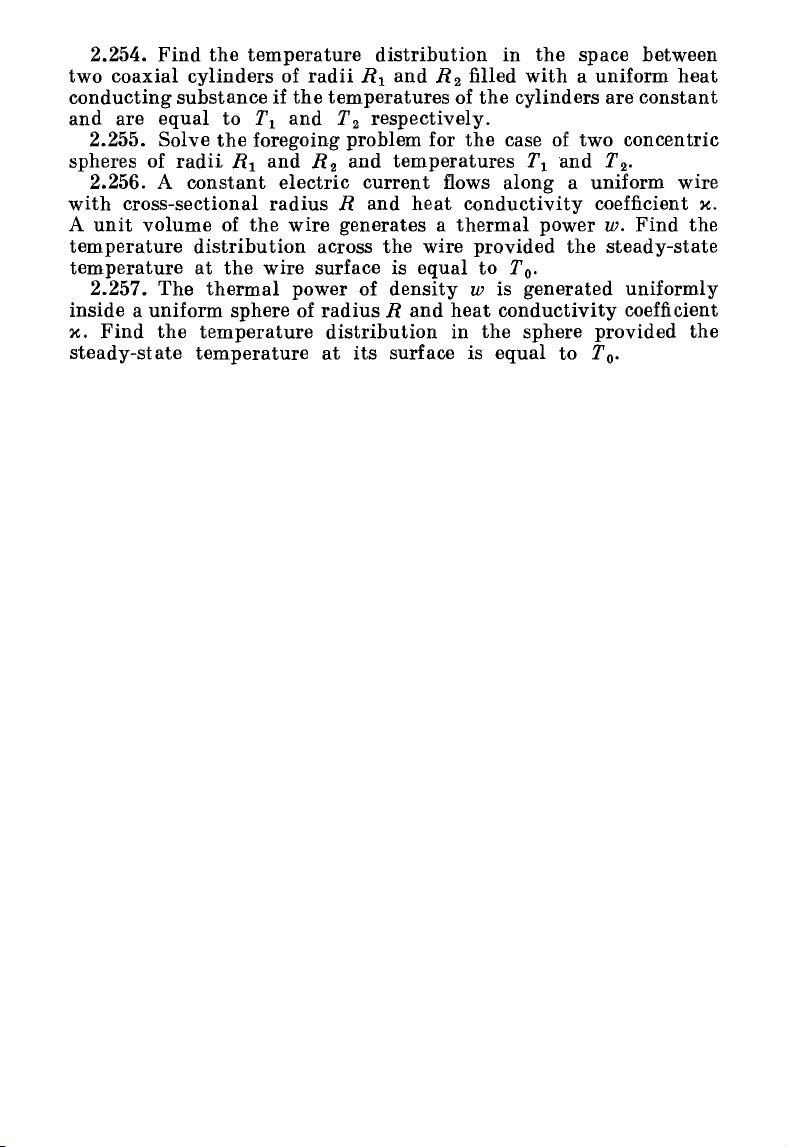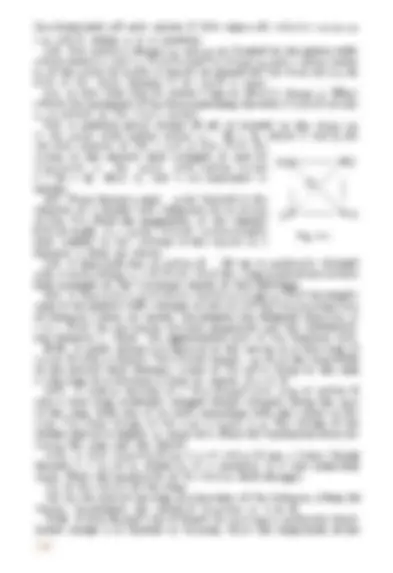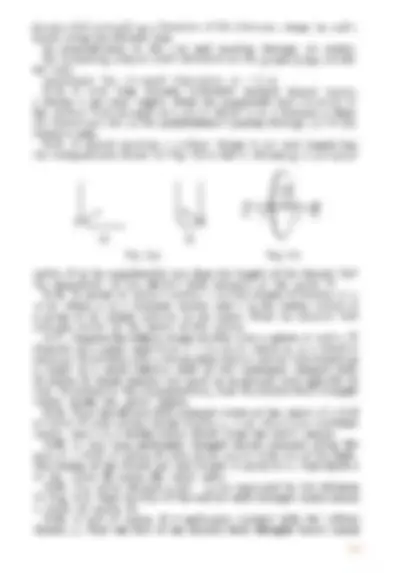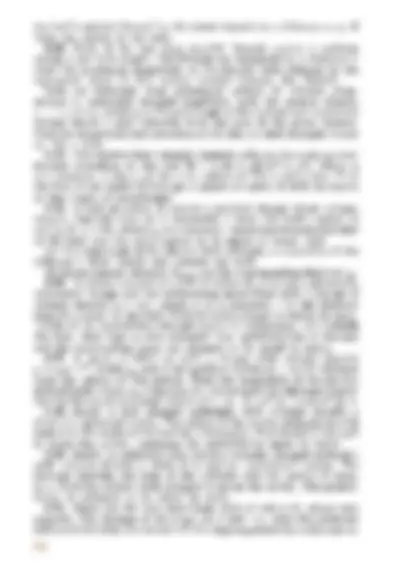





Study with the several resources on Docsity

Earn points by helping other students or get them with a premium plan


Prepare for your exams
Study with the several resources on Docsity

Earn points to download
Earn points by helping other students or get them with a premium plan
Community
Ask the community for help and clear up your study doubts
Discover the best universities in your country according to Docsity users
Free resources
Download our free guides on studying techniques, anxiety management strategies, and thesis advice from Docsity tutors
irodov_problems_in_general_physics_2011
Typology: Study Guides, Projects, Research
1 / 5

This page cannot be seen from the preview
Don't miss anything!




2.254. Find the temperature distribution in the space between two coaxial cylinders of radii R1and R 2 filled with a uniform heat conducting substance if the temperatures of the cylinders are constant and are equal to T1and T2 respectively. 2.255. Solve the foregoing problem for the case of two concentric spheres of radii. R1and R2 and temperatures T1 and T2. 2.256. A constant electric current flows along a uniform wire with cross-sectional radius R and heat conductivity coefficient x. A unit volume of the wire generates a thermal power w. Find the temperature distribution across the wire provided the steady-state temperature at the wire surface is equal to To. 2.257. The thermal power of density w is generated uniformly inside a uniform sphere of radius R and heat conductivity coefficient x. Find the temperature distribution in the sphere provided the steady-state temperature at its surface is equal to To.
3.1. CONSTANT ELECTRIC FIELD IN VACUUM
1 q ID 4ns, F.- (3.1a)
IS)E dS = q/so, 1;;,E dr = 0. (3.1c)
1 eo
p E = (^) 4n r3 171+3cos2 0, (3.1d)
where 0 is the angle between the vectors r and p.
VE is the gradient of the function Ex.
3.1. Calculate the ratio of the electrostatic to gravitational inter- action forces between two electrons, between two protons. At what value of the specific charge qlm of a particle would these forces be- come equal (in their absolute values) in the case of interaction of identical particles? 3.2. What would be the interaction force between two copper spheres, each of mass 1 g, separated by the distance 1 m, if the total electronic charge in them differed from the total charge of the nuclei by one per cent? 3.3. Two small equally charged spheres, each of mass m, are suspended from the same point by silk threads of length 1. The distance between the spheres x << 1. Find the rate dqldt with which
electric field strength as a function of the distance (^) r from the rod's centre along the straight line (a) perpendicular to the rod and passing through its centre; (b) coinciding with the rod's direction (at the points lying outside the rod).
3.14. A very long straight uniformly charged thread carries a charge A. per unit length. Find the magnitude and direction of the electric field strength at a point which is at a distance y from the thread and lies on the perpendicular passing through one of the thread's ends. 3.15. A thread carrying a uniform charge X per unit length has the configurations shown in Fig. 3.2 a and b. Assuming a curvature
R
(a) (^) (b)
Fig. 3.2. Fig. 3.3.
radius R to be considerably less than the length of the thread, find the magnitude of the electric field strength at the point 0. 3.16. A sphere of radius (^) r carries a surface charge of density a ar, where a is a constant vector, and r is the radius vector of a point of the sphere relative to its centre. Find the electric field strength vector at the centre of the sphere. 3.17. Suppose the surface charge density over a sphere of radius R depends on a polar angle 0 as a = aocos 0, where aois a positive constant. Show that such a charge distribution can be represented as a result of a small relative shift of two uniformly charged balls of radius R whose charges are equal in magnitude and opposite in sign. Resorting to this representation, find the electric field strength vector inside the given sphere. 3.18. Find the electric field strength vector at the centre of a ball of radius R (^) with volume charge density p = ar, where a is a constant vector, and r is a radius vector drawn from the ball's centre. 3.19. A very long uniformly charged thread oriented along the axis of a circle of radius (^) R rests on its centre with one of the ends. The charge of the thread per unit length is equal to Find the flux of the vector E across the circle area. 3.20. Two point charges q and —q are separated by the distance 21 (Fig. 3.3). Find the flux of the electric field strength vector across a circle of radius R. 3.21. A ball of radius (^) R is uniformly charged with the volume density p. Find the flux of the electric field strength vector across
the ball's section formed by the plane located at a distance 7.0 < R from the centre of the ball. 3.22. Each of the two long parallel threads carries a uniform charge per unit length. The threads are separated by a distance 1. Find the maximum magnitude of the electric field strength in the symmetry plane of this system located between the threads. 3.23. An infinitely long cylindrical surface of circular cross- section is uniformly charged lengthwise with the surface density a = aocos cp, where pis the polar angle of the cylindrical coordinate system whose z axis coincides with the axis of the given surface. Find the magnitude and direction of the electric field strength vector on the z axis. 3.24. The electric field strength depends only on the x and y coor- dinates according to the law E = a (xi + yj)/(x2 + y2), where a is a constant, i and j are the unit vectors of the x^ and y axes. Find the flux of the vector E through a sphere of radius R with its centre at the origin of coordinates. 3.25. A ball of` radius R carries a positive charge whose volume density depends only on a separation r from the ball's centre as Po (1 — rIR), where Pois a constant. Assuming the permittivities of the ball and the environment to be equal to unity, find: (a) the magnitude of the electric field strength as a function of the distance r both inside and outside the ball; (b) the maximum intensity Ema, and the corresponding distance rm. 3.26. A system consists of a ball of radius R carrying a spherically symmetric charge and the surrounding space filled with a charge of volume density p = air, where a is a constant, r is the distance from the centre of the ball. Find the ball's charge at which the mag- nitude of the electric field strength vector is independent of r outside the ball. How high is this strength? The permittivities of the ball and the surrounding space are assumed to be equal to unity. 3.27. A space is filled up with a charge with volume density p = Poe-a''3, where Poand a are positive constants, r is the distance from the centre of this system. Find the magnitude of the electric field strength vector as a function of r. Investigate the obtained expres- sion for the small and large values of r, i.e. at (^) ar3 < 1 and ar3>> 1. 3.28. Inside a ball charged uniformly with volume density p there is a spherical cavity. The centre of the cavity is displaced with respect to the centre of the ball by a distance a. Find the field strength E inside the cavity, assuming the permittivity equal to unity. 3.29. Inside an infinitely long circular cylinder charged uniformly with volume density p there is a circular cylindrical cavity. The distance between the axes of the cylinder and the cavity is equal to a. Find the electric field strength E inside the cavity. The permit- tivity is assumed to be equal to unity. 3.30. There are two thin wire rings, each of radius R, whose axes coincide. The charges of the rings are q and —q. Find the potential difference between the centres of the rings separated by a distance a.
108